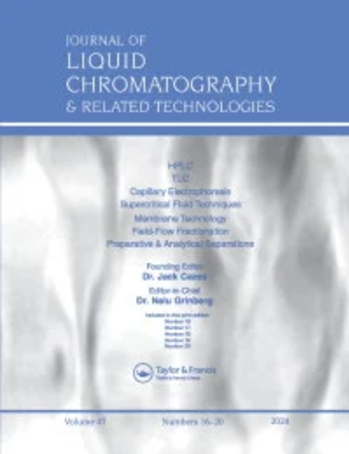Separation techniques for intact antibody analysis by mass spectrometry
IF 1.2
4区 化学
Q4 BIOCHEMICAL RESEARCH METHODS
Journal of Liquid Chromatography & Related Technologies
Pub Date : 2022-12-14
DOI:10.1080/10826076.2023.2199328
引用次数: 0
Abstract
Abstract The possibilities to directly couple different separation methods with mass spectrometry (MS) for the analysis of intact proteins has attracted significant attention over the last decade. While sample preparation is critical for MS analyses, coupling an efficient separation method before MS can significantly improve the ability to resolve protein heterogeneity and reveal intact masses or higher-order structure information (e.g., PTM or conformation changes). To that end, this review focuses on common online separation techniques coupled with MS detection to detect antibodies or large proteins with a focus on biopharmaceutical applications. An overview of liquid chromatography modes, such as reversed-phase, size-exclusion, mixed-mode, hydrophobic interaction, and ion-exchange chromatography will be discussed, along with electrophoretic separation, gas-phase separation using ion-mobility and other next-generation tools. Finally, the application space within the biopharmaceutical industry will be discussed along with how improvements for separation techniques before MS detection can ultimately help characterize charge-, size-, or hydrophobic variants of novel biotherapeutics throughout all stages of drug development. GRAPHICAL ABSTRACT质谱法分析完整抗体的分离技术
摘要在过去的十年里,将不同的分离方法与质谱(MS)直接结合用于分析完整蛋白质的可能性引起了人们的极大关注。虽然样品制备对质谱分析至关重要,但在质谱分析之前结合有效的分离方法可以显著提高解决蛋白质异质性和揭示完整质量或高阶结构信息(例如PTM或构象变化)的能力。为此,本综述侧重于常见的在线分离技术与质谱检测相结合,以检测抗体或大蛋白,重点关注生物制药应用。将讨论液相色谱模式的概述,如反相、尺寸排阻、混合模式、疏水相互作用和离子交换色谱,以及电泳分离、使用离子迁移率的气相分离和其他下一代工具。最后,将讨论生物制药行业的应用空间,以及在MS检测之前对分离技术的改进如何最终有助于在药物开发的所有阶段表征新型生物治疗药物的电荷、大小或疏水性变体。图形摘要
本文章由计算机程序翻译,如有差异,请以英文原文为准。
求助全文
约1分钟内获得全文
求助全文
来源期刊
CiteScore
2.80
自引率
0.00%
发文量
29
审稿时长
4.9 months
期刊介绍:
The Journal of Liquid Chromatography & Related Technologies is an internationally acclaimed forum for fast publication of critical, peer reviewed manuscripts dealing with analytical, preparative and process scale liquid chromatography and all of its related technologies, including TLC, capillary electrophoresis, capillary electrochromatography, supercritical fluid chromatography and extraction, field-flow technologies, affinity, and much more. New separation methodologies are added when they are developed. Papers dealing with research and development results, as well as critical reviews of important technologies, are published in the Journal.

 求助内容:
求助内容: 应助结果提醒方式:
应助结果提醒方式:


